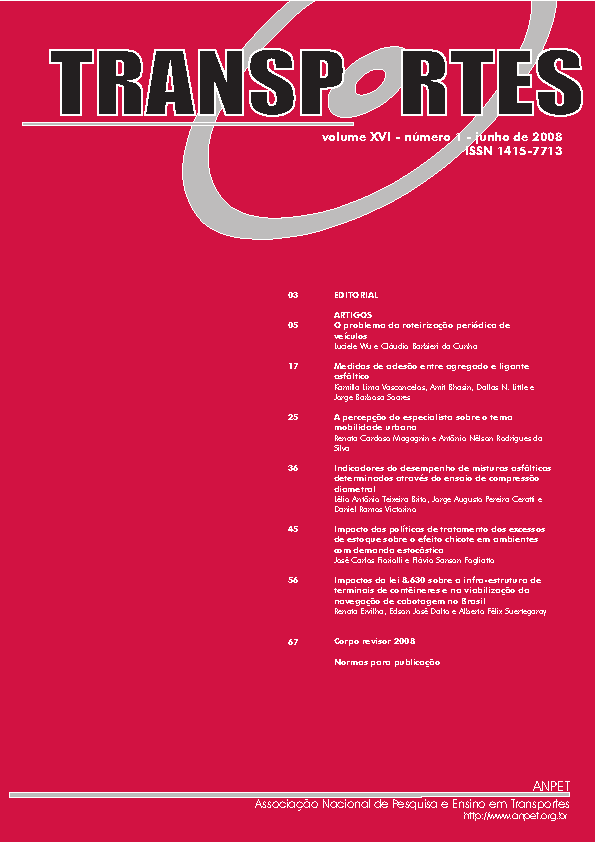Medidas de adesão entre agregado e ligante asfáltico
DOI:
https://doi.org/10.14295/transportes.v16i1.9Abstract
A adesão entre agregado e ligante asfáltico vem sendo apontada como uma propriedade de grande importância para a causa de defeitos encontrados em pavimentos asfálticos, tais como trincas por fadiga, e dano por umidade. Diferentes mecanismos existem na literatura para explicar a adesão entre os dois materiais, porém, estes mecanismos podem ser resumidos em três grandes grupos: inter- travamento mecânico, adesão física, e interação química. A ocorrência de mais de um mecanismo simultaneamente parece ser o fenô- meno mais provável, sendo a relevância de cada um dependente das características físicas e químicas do agregado e do ligante asfálti- co. No presente trabalho, dois procedimentos foram utilizados para acessar a adesão entre agregado e ligante. O primeiro constou do cálculo do trabalho de adesão através da energia livre de superfície dos materiais envolvidos e o segundo, da determinação da entalpia de imersão quando soluções de asfalto são postas em contato com o agregado. Todos os materiais usados foram provenientes da biblio- teca de referência do SHRP sendo um pedregulho como agregado, e três diferentes ligantes asfálticos. Os resultados mostraram a capa- cidade do microcalorímetro em detectar possíveis interações químicas na adesão entre agregado e ligante asfáltico, em conjunto com adesão física. A presença de grupos funcionais mais fortemente adsorvidos pela superfície dos agregados justificou os maiores valores de entalpia de imersão para as combinações onde esses grupos se encontravam presentes.
Abstract Adhesion between the asphalt binder and the aggregate is critical to the performance and durability of asphalt mixtures. According to the literature, distresses mechanisms such as fatigue cracking and moisture induced damage are correlated to the nature and quality of adhesion between these two materials. Different mechanisms already exist to explain adhesion, but they can be summa- rized in three main groups: mechanical interlocking, physical adhesion and chemical interaction. Although discussions of isolated theo- ries and mechanisms help to clarify the understanding of adhesion, they can rarely be separated completely to each other. The physical and chemical characteristics of asphalt and aggregate will in fact determine the relevance of each of these mechanisms. This study presents the results of two procedures for adhesion measurement: (i) an indirect method based on the surface free energy components of asphalt binder and aggregate; and (ii) the determination of the enthalpy of immersion through the use of a microcalorimeter. The materials used, a gravel as aggregate and three different neat asphalts, were provided by the Strategic Highway Research Program's Material Reference Library. The results showed the capacity of the microcalorimeter in detecting possible chemical reactions together with physical adhesion. The presence of functional groups more strongly adsorbed by the aggregate surface justified the higher values of the heat of immersion.
Downloads
Downloads
Published
How to Cite
Issue
Section
License
Authors who submit papers for publication by TRANSPORTES agree to the following terms:
- The authors retain the copyright and grant Transportes the right of first publication of the manuscript, without any financial charge, and waive any other remuneration for its publication by ANPET.
- Upon publication by Transportes, the manuscript is automatically licensed under the Creative Commons License CC BY 4.0 license. This license permits the work to be shared with proper attribution to the authors and its original publication in this journal.
- Authors are authorized to enter into additional separate contracts for the non-exclusive distribution of the version of the manuscript published in this journal (e.g., publishing in an institutional repository or as a book chapter), with recognition of the initial publication in this journal, provided that such a contract does not imply an endorsement of the content of the manuscript or the new medium by ANPET.
- Authors are permitted and encouraged to publish and distribute their work online (e.g., in institutional repositories or on their personal websites) after the editorial process is complete. As Transportes provides open access to all published issues, authors are encouraged to use links to the DOI of their article in these cases.
- Authors guarantee that they have obtained the necessary authorization from their employers for the transfer of rights under this agreement, if these employers hold any copyright over the manuscript. Additionally, authors assume all responsibility for any copyright infringements by these employers, releasing ANPET and Transportes from any responsibility in this regard.
- Authors assume full responsibility for the content of the manuscript, including the necessary and appropriate authorizations for the disclosure of collected data and obtained results, releasing ANPET and Transportes from any responsibility in this regard.










